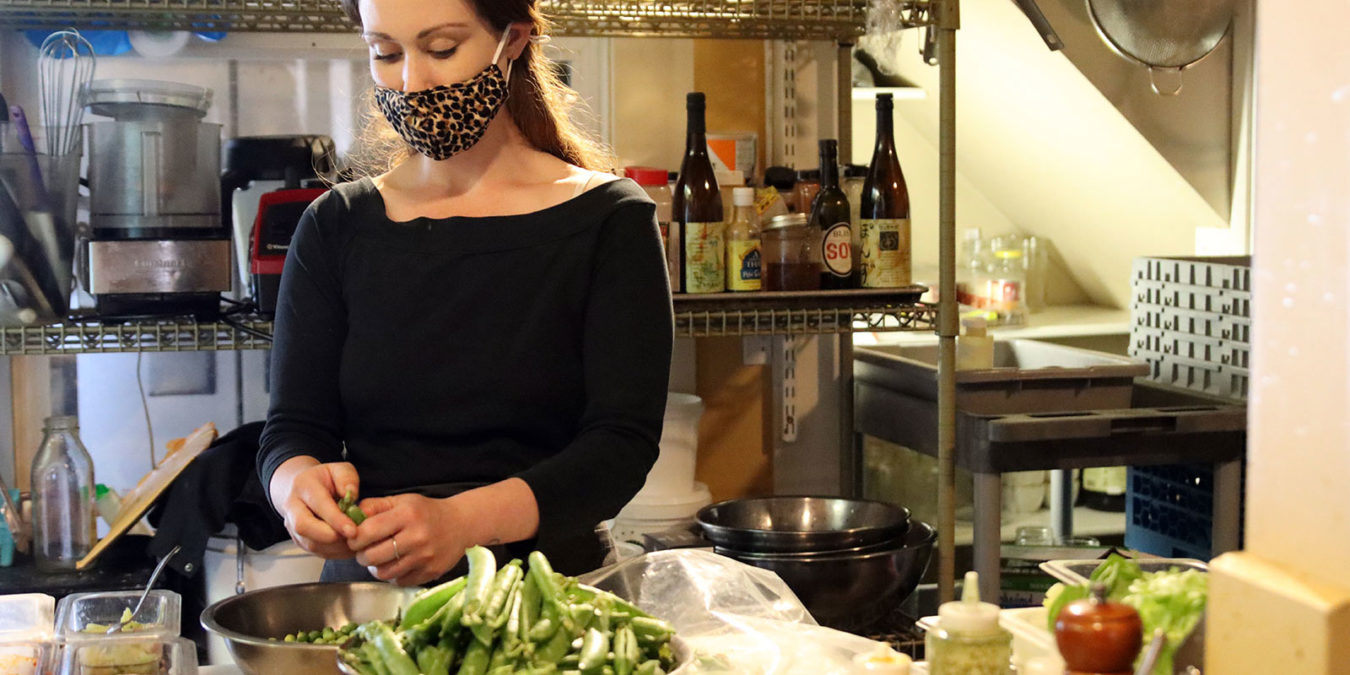 Anna Maria and Dave recently journeyed straight to the source of many of the fine wines served nightly at Coho. Below is her account of their whirlwind weekend!
Anna Maria and Dave recently journeyed straight to the source of many of the fine wines served nightly at Coho. Below is her account of their whirlwind weekend!
Coho’s wine list is a gathering of old friends, many of which we discovered from industry tastings or from our travels. The wines tell a story, either about the winemaker or about the terroir [soil] where the grapes are grown. While we have some highly sought after wines, many touted with rave reviews on Parker’s wine list, we prefer discovering and showcasing small boutique producers that are not necessarily part of the wholesale distribution network. It is always a bittersweet moment when one of ‘our’ wines shows up on Parker’s list. We are thrilled for the winemaker, but we are also sad, as it means that the wine will be in high demand. It will be difficult to procure, even though we bought it regularly prior to its notoriety.
So in November, we set out on a discovery mission. Walla Walla seemed like the obvious choice. Not only did we know a small base of winemakers there, but we also had never been east of the Cascades since moving here ten years ago. Once we started planning and networking, our schedule took on a life of its own. We ended up meeting with 23 winemakers over just four days. It was an amazing learning experience, and a lot of hard work.
We arrived in Walla Walla on Sunday afternoon, the end of “Fall Release Weekend,” the big culminating event that marks the end of harvest. The wineries were still busy crushing the last of the season’s fruit, finishing up primary fermentation, and moving juice into barrels for secondary fermentation. By the time we checked into our inn later that evening, we had five wineries under our belt.
Which are the Favorites?
Of course, everyone wants to know which was our favorite. That’s not a fair question! It would be like asking a parent to choose their favorite child. To me, a favorite depends on so many factors: the time of year (we tend to drink more reds during fall and winter), what I am eating for dinner (I am not a whites-only purist for fish, chicken and pork, but food pairing is indeed a consideration), and most importantly, whimsy (do I want new or old world in my glass, bubbly still, red or white?)
The other part of this question is whether a wine will be a favorite now or 2 to 5 years from now. During our visit, we did a lot of barrel tastings. Many of these wines won’t be released until spring at the earliest, some not until five years from now. There were wines just released during our visit that, while drinking well now, could definitely benefit from cellaring and the elegance that aging brings to wine. This offers us restaurateurs a unique challenge. While we need to focus on purchasing wine that drinks well now, we don’t want to be too shortsighted to neglect wine that benefits from cellaring. There were many wines that could easily be my favorite in 2 to 10 years with a bit of aging.
So back to favorites….since this was fall release weekend, we tasted about 90% red and 10% whites. I’ll start with the whites as they are the easiest. Next time, I will include the notable reds. Here are four notable whites that will be on our list this spring:
Poets Leap Riesling, Long Shadows, 2012, 100% Riesling, Columbia Valley: beautifully crafted German-style Riesling with aromatics of honey suckle, dried apricots and a hint of honey that provides a lingering finish. 1.25% RS.
Seven Hills Estate Pinot Grigio, 2011, Oregon (Part of the Walla Walla AVA includes Oregon): this wine has notes of citrus, pear and hazelnut on the nose and sees a touch of French oak to give it a viscous mouth feel. It has a bright citrus finish.
DaMa Chardonnay, 2011, 100% Chardonnay, Columbia Valley: aromas of toasted almonds and lemon curd with floral notes. Aged in neutral oak, there is a nice rounded mouth feel with a bright acidity.
Tranche, Slice of Pape Blanc 2010, Columbia Valley, 66% Roussane, 34% Viognier: a nicely balanced wine that deftly blends the aromatics of the Viognier, violets and jasmine and fresh ripe cantaloupe with the Roussanne finishing with a lovely Meyer lemon and lime zest acidity; long savory finish.
The Winery Experience
Coincidentally, these four wineries demonstrate the cross-spectrum of winemaking in the valley, from DaMa, a small independent winery started by two passionate women, to the Long Shadows project, brainchild of the former CEO of Chateau Ste. Michelle, which has seven acclaimed winemakers working under one roof.
When we arrived at DaMa’s downtown store front, winemaker Mary Tuuri Derby was huddled on the floor wrapping boxes of fall release wine for DaMa Nation members. They don’t have their own winemaking facilities. They have a “co-op” arrangement with other winemakers and share equipment at a separate venue.
Long Shadows Vintners, accessed from a long, dusty road off the main highway, sits atop a big hill facing Blue Mountain. We entered the large red rectangular complex directly into the Chihuly Room. In this large gathering room, there is floor to ceiling glass on one side overlooking the valley. The opposite wall has windows overlooking cellar operations, where rows and rows of stainless steel tanks stand at attention with a beehive of crew cleaning, moving equipment, and tending to tanks. As we sat tasting wine and sampling local cheese, we were dwarfed by a massive glass chandelier, and surrounded by a glass garden and huge floral tulips that stood at least eight feet tall.
The Long Shadows winery operation is state of the art. The touch screen computer on the main cellar wall manages and tracks operations for the winemakers and cellar crew. In one click, you could check on the fermentation progress of each of the tanks. Pump-overs and temperature control, via a Glycol system, could be done by another click.
Casey McClellan, winemaker of Seven Hills, visited San Juan Island on several occasions. We carry their Klipsun Vineyards Red Mountain Cabernet and their Ciel du Cheval Red Blend. McClellan’s winery is located downtown, in the historic Whitehouse Crawford building. It shares a glass wall of the cellar with a fine dining restaurant, which is a reminder of the connection between food and wine. The day we arrived, Casey was clearly in his element, running up and down the ladders checking on his fermentation tanks; he thinks of himself as a big-little winery. Their production is medium-sized for the valley, but his cellar operations are very compact and efficient.
We had the pleasure of hosting Michael and Lauri Corliss for dinner at Coho shortly after we opened the restaurant. They enjoyed a bottle of their Syrah with dinner. As they left the restaurant, they gave us a bottle, wrapped in white tissue that was twisted tightly around the neck. The punt, the large dimple at the bottom of the bottle, bore Corliss’ signature wax seal. Corliss isn’t part of the formal distribution system and in our early days, that posed a bit of a problem. Over the years, we have figured out creative ways of getting wine for Coho’s list outside the regular distribution channels. So when we were planning our trip to Walla Walla, we remembered that special bottle and knew we needed to pay them a visit. Now with their sister winery, Tranche, they are producing a larger variety of wines.
Tranche, meaning “slice”, is the companion project to Corliss Vineyard. The winery complex has a large reception area and tasting bar, as well as an exposed two-floor atrium with massive recycled wood beams. The upstairs floor doubles as Michael and Lauri Corliss’ private owners’ quarters, complete with a commercial kitchen for receptions and entertaining, and a “tasting” room. This totally isolated space, complete with its own air supply, temperature, and noise control, was built to eliminate sensory distraction. It is used regularly for focused tasting and blending meetings. Their cellar is an underground labyrinth of corridors housing library wines and upcoming releases. Corliss holds their wine for a minimum of five years before release, so even though they are small production with only 2000 cases per year, that’s a lot of storage over five years. Their cellar operations floor is accessed by a raised metal catwalk, which provides an ergonomic way to access and clean the tanks without using tall ladders.
But despite the range of operations, the wine produced by the small producers – less than 2,000 per year like Da Ma and 2,500 cases like Tranche, up to larger houses like Seven Hills and Long Shadow that currently produce about 7,000 cases each — is outstanding.
I have barely scratched the surface of our four-day whirlwind trip. Next time, I will include a companion post highlighting the notable reds, their winemakers, and behind-the-scenes vignettes from those wineries. So stay tuned.
The talent, passion, and remarkable wines in the valley overwhelmed us. While we were familiar with many winemakers prior to this trip, there is nothing like being on their turf and seeing their operation to elicit a sense of place. Tasting through their portfolio offers insight to the subtleties of their style. So when we pull a cork for a guest tableside, there will be a provenance, a story and a friend we can talk about. As a result of this trip, we have many new friends to add to our list and great stories to share with our guests tableside.

